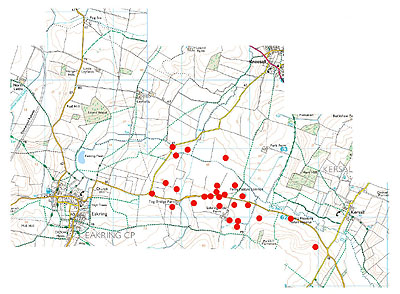

| The Quail influx 2001 |
| The area
provided record numbers of Quail during 2001, attracting
numerous listeners on fine evenings during their lengthy
stay around both Tug Bridge and Eakring Field Farms.
Quail had'nt been recorded here since four birds in May
1998. Despite a good influx into the country last year,
none were found despite diligent searching of the entire
area. The final count of males this year, proved to be
one of the highest totals for any one area in the
country. The first calling Quail this year, was in Oil Seed Rape at Eakring Field Farm from May 26th, (arrival at same site in 1998 being May 20th) with a second bird present at nearby Parkhill Plantation from May 29-June 7th. On June 8th, a third bird was discovered in the Eakring Meadows area, calling distantly from the stubble field opposite the Kersall end of the reserve. This bird was rarely noted after it's initial discovery. June 10th saw another influx take place, when a total of seven birds were found calling at Eakring Field Farm, Parkhill Plantation, Penny Pasture Common.and two sites along the Kneesall Road. By the 18th, some nine males had been located. Positional mapping of these males, helped to determine their movements and territories during this time. Checking sites away from roadside locations proved fruitful on the 20th, when two more males were located in the sprayed set-aside to the south-east of Eakring Field Farm. These, with a further two new arrivals by the roadside in front of the farm, mean that at that time, some 14 males had been located in the area (seven of which were now situated at Eakring Field Farm) Some movements by certain males were suspected to have taken place. Two of the Tug Bridge Farm birds, were considered to be accountable for the new males which arrived at nearby Eakring Field Farm. This theory was dispelled however, when all the original Tug Bridge Farm birds, plus one new arrival began calling again on June 25th. What was now clear though, was that despite failing to call for many days, males remained in territories attained on arrival, rarely venturing more than fifty yards or so. |
| .... | |
| Continued monitoring now showed that the
full total of males had now reached 17 birds and July saw another series
of arrivals. Following on from a new bird found near Parkhill Plantation on the 1st, the total crept up to 18 males. With high pressure and easterly winds dominating proceedings during the first few days, conditions were similar to that which led to the arrivals of mid-June. On July 4th, another major arrival took place and nine new, actively calling males were found. As such, the total now was 27 males. Allowing for a female count of perhaps another 15 birds, then the total probably touched over 40. This however was obviously conjecture, but such a total must have been highly probable. Observations made during the course of this year, were that birds remained in their respective areas after arrival and territories were found to be suprisingly small, probably little more than 50 square yards. Calling was most consistant and energetic from arrival and for a period of around 4/5 days. |
 |
| .... | |
| It was found that periods of song from
long-staying males, gradually shortened (sometimes to
only two or three times an evening) a week after arrival
and that in all cases, males often ceased to call
entirely for lengthy periods (sometimes lasting for over
a week) leading to the impression that the birds had left
the area. In most cases however, influxes of new birds,
produced a resumption (though quite short-lived) in
active calling from earlier arriving males. Both major
arrivals, on June 10th and July 4th, occurred during
spells of fine warm weatherand easterly based winds,
associated with high pressure systems over the UK and
nearby Continent at the time. Quail remained in the area well into August, when calling males were heard at Eakring Flash briefly on the 18th. These records clearly relate to birds which relocated, after the harvesting of crops around Eakring Field and Tug Bridge Farms. Nottinghamshire status The Quail is a regular (but uncommon) visitor to Nottinghamshire. It's obviously an under-recorded species, found most years in variable numbers, it's status being re-inforced by the male's habit of predominantly calling during the late evening and early morning periods. Males calling during daylight hours probably account for most of the records submitted each year. Systematic and regular listening during the late evening elsewhere, would probably reveal far more. |
|